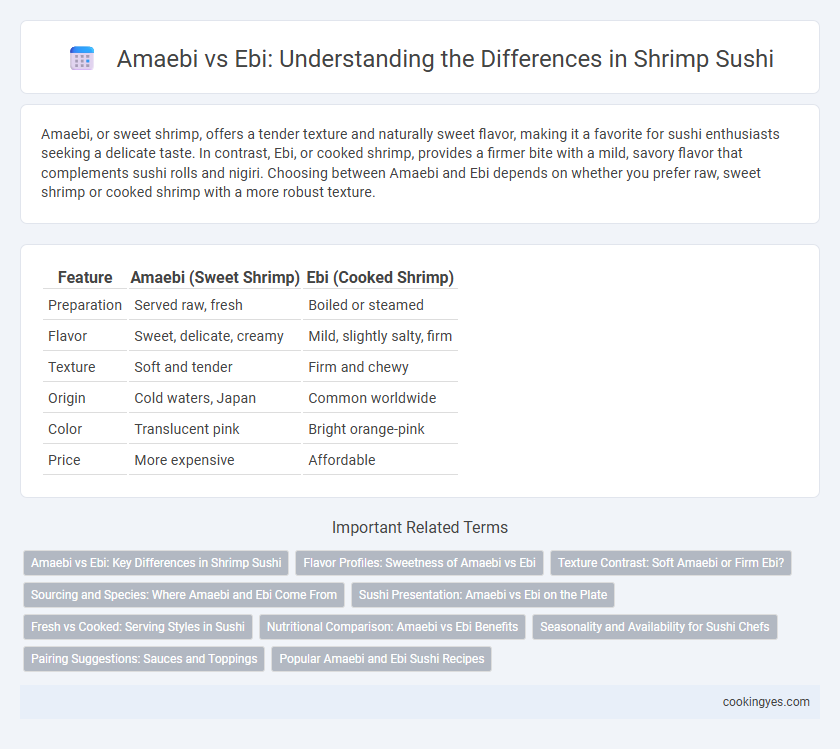Amaebi, or sweet shrimp, offers a tender texture and naturally sweet flavor, making it a favorite for sushi enthusiasts seeking a delicate taste. In contrast, Ebi, or cooked shrimp, provides a firmer bite with a mild, savory flavor that complements sushi rolls and nigiri. Choosing between Amaebi and Ebi depends on whether you prefer raw, sweet shrimp or cooked shrimp with a more robust texture.
Table of Comparison
| Feature | Amaebi (Sweet Shrimp) | Ebi (Cooked Shrimp) |
|---|---|---|
| Preparation | Served raw, fresh | Boiled or steamed |
| Flavor | Sweet, delicate, creamy | Mild, slightly salty, firm |
| Texture | Soft and tender | Firm and chewy |
| Origin | Cold waters, Japan | Common worldwide |
| Color | Translucent pink | Bright orange-pink |
| Price | More expensive | Affordable |
Amaebi vs Ebi: Key Differences in Shrimp Sushi
Amaebi, or sweet shrimp, is prized for its tender texture and naturally sweet flavor, served raw to highlight its freshness in sushi. In contrast, Ebi refers to cooked shrimp, offering a firmer texture and a savory taste that complements various sushi preparations. The key differences between Amaebi and Ebi lie in their preparation methods, flavor profiles, and texture, making each suitable for different sushi experiences.
Flavor Profiles: Sweetness of Amaebi vs Ebi
Amaebi offers a delicate sweetness with a tender, buttery texture that enhances its raw, fresh flavor, making it a prized choice for sushi enthusiasts. Ebi, typically cooked, provides a firmer bite with a mild, slightly salty taste that complements its subtle shrimp essence. The contrast between Amaebi's natural sweetness and Ebi's savory profile highlights different aspects of shrimp sushi that cater to varied palate preferences.
Texture Contrast: Soft Amaebi or Firm Ebi?
Amaebi offers a delicate, buttery texture that melts in the mouth, creating a luxurious experience distinct from the firm, slightly chewy bite of Ebi. The soft, raw Amaebi provides a subtle sweetness and smoothness, contrasting with the cooked Ebi's robust and springy texture. This difference in texture plays a crucial role in sushi preferences, highlighting Amaebi's tender freshness versus Ebi's satisfying firmness.
Sourcing and Species: Where Amaebi and Ebi Come From
Amaebi, or sweet shrimp, is primarily sourced from cold waters off Japan, Russia, and Alaska, belonging to the species *Pandalus borealis*, known for its tender texture and naturally sweet flavor. Ebi, commonly referring to cooked shrimp used in sushi, typically comes from warmer waters, including Southeast Asia and the Gulf of Mexico, with species like *Litopenaeus vannamei* dominating global shrimp aquaculture. The sourcing environment and species differences significantly influence the taste, texture, and culinary use of both Amaebi and Ebi in sushi preparation.
Sushi Presentation: Amaebi vs Ebi on the Plate
Amaebi presents as translucent pink shrimp with a delicate, glossy finish, enhancing the visual allure of sushi plates with its raw, tender texture. Ebi features cooked shrimp, typically brighter orange and firmer, offering a more vibrant and structured appearance that contrasts well with sushi rice. The subtle differences in color and texture between Amaebi and Ebi elevate the overall plate presentation, appealing to both visual aesthetics and texture variety in sushi dining.
Fresh vs Cooked: Serving Styles in Sushi
Amaebi is served raw, prized for its sweet, delicate flavor and tender texture, making it a favorite in fresh sushi dishes. Ebi is cooked, offering a firmer texture and a slightly savory taste ideal for those preferring cooked seafood in sushi. The choice between Amaebi and Ebi highlights the contrast between fresh and cooked shrimp serving styles in traditional sushi preparation.
Nutritional Comparison: Amaebi vs Ebi Benefits
Amaebi (sweet shrimp) contains higher levels of omega-3 fatty acids and has a richer source of vitamin B12 compared to Ebi (cooked shrimp), benefiting heart and brain health. Ebi offers a lower calorie count and more protein per serving, making it an excellent choice for weight management and muscle maintenance. Both types provide essential minerals like selenium and iodine, supporting immune function and thyroid health.
Seasonality and Availability for Sushi Chefs
Amaebi, also known as sweet shrimp, is prized for its delicate sweetness and is typically available fresh during colder months, especially from late fall to early spring, making it a seasonal delicacy for sushi chefs. In contrast, Ebi, or boiled shrimp, enjoys year-round availability due to widespread aquaculture farming, providing chefs with a reliable option regardless of season. Understanding the seasonal peak of Amaebi allows sushi chefs to optimize menu offerings and highlight freshness, while Ebi serves as a versatile alternative throughout the year.
Pairing Suggestions: Sauces and Toppings
Amaebi sushi, known for its sweet and delicate flavor, pairs exceptionally well with light soy sauce and a touch of yuzu kosho to enhance its natural sweetness without overpowering the shrimp. Ebi sushi, which has a firmer texture and milder taste, benefits from a topping of spicy mayo or a dab of wasabi alongside soy sauce to add depth and contrast. Freshly grated ginger or a sprinkle of toasted sesame seeds can complement both types, balancing the subtle nuances of shrimp sushi.
Popular Amaebi and Ebi Sushi Recipes
Amaebi and Ebi are two popular shrimp varieties used in sushi, with Amaebi known for its sweet, tender texture often served raw, highlighting recipes like Amaebi nigiri and Amaebi sashimi. Ebi, typically boiled or steamed, offers a firmer texture and is commonly featured in Ebi nigiri and spicy shrimp rolls. Both shrimp types contribute distinct flavors, making them staples in sushi menus worldwide.
Amaebi vs Ebi for Shrimp Sushi Infographic

 cookingyes.com
cookingyes.com